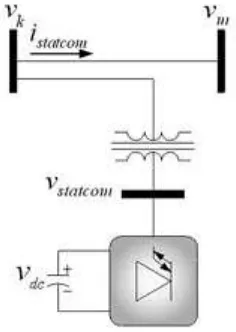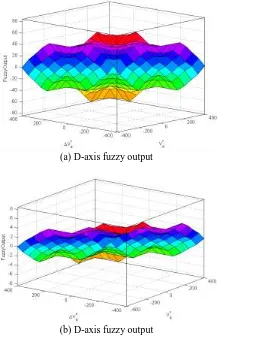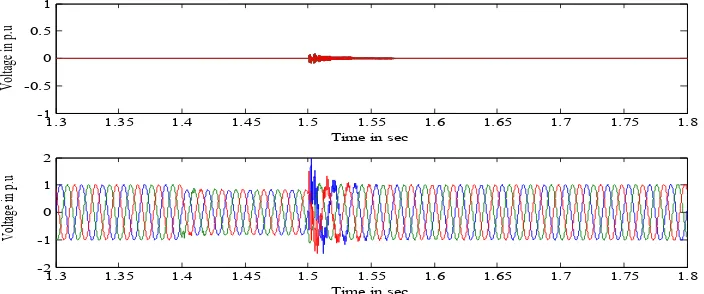e-ISSN: 2278-067X, p-ISSN: 2278-800X, www.ijerd.com
Volume 9, Issue 7 (January 2014), PP. 01-08
Implementation of PSS and STATCOM Controllers for
Power System Stability Enhancement
A.S.Kannan
1, R.Kayalvizhi
21Department of Electrical & Electronics Engineering, Annamalai University, Tamil Nadu, India.
2
Department of Instrumentation Engineering, Annamalai University, Tamil Nadu, India.
Abstract:- In emerging electric power systems, enlarged communication often lead to the situations where the structure no longer remains in secure operating region. The flexible Ac transmission system (FACTS) controllers can take part in an important role in the power system security enhancement. However, due to high capital investment, it is necessary to locate these controllers optimally in the power system. This paper presents an application of fuzzy control to determine the control signal of static compensator (STATCOM) for improvement of power system stability. STATCOM is a shunt type FACTS device which is used in power system primarily for the purpose of voltage and reactive power control. A fuzzy logic based supplementary controller for Static Compensator(STATCOM) is developed which is used for damping the rotor angle oscillations and to improve the transient stability of the power system. Generator speed and the electrical power are chosen as input signals for the fuzzy logic controller (FLC). A Standard 3-phase, six bus system is taken as test system to evaluate the FACTS device (STATCOM) performance for proposed controllers PI and fuzzy with Power System Stabilizer in multi machine system.
Keywords:- Fuzzy Logic Control, PI Controller, Power System Stabilizer, STATCOM.
I.
INTRODUCTION
Flexible ac Transmission Systems (FACTS) devices have emerged in power system because of the development of power electronics components for high voltage and power. The FACTS devices provide higher controllability in power systems by means of power electronic devices. Several FACTS equipments have been already introduced for various applications worldwide, and new types of FACTS are in the stage of being introduced in practice. FACTS technology provides a better ability to varying operational conditions and improves the usage of existing installations. The flexible AC transmission system is akin to high voltage DC and related thyristor developments, designed to overcome the limitations of the present mechanically controlled AC power transmission systems. By using reliable and high-speed power electronic controllers, the technology offers five opportunities for increased efficiency of utilities.
Greater control of power so that it flows on the prescribed transmission routes.
Secure loading of transmission lines to levels nearer their thermal limits.
Greater ability to transfer between controlled areas.
Prevention of cascading outages.
Damping of power system oscillation.
Static Var compensator (SVC) improves the system performances by controlling the magnitude of voltage. Thyristor controlled phase angle regulator (TCPAR) controls the phase angle of voltage, while thyristor controlled series compensator (TCSC) changes the effective impedance of transmission line to the system performance. The unified power flow controller (UPFC) offers to combine all three functions in one device [4,5]. The control of system parameters can be carried out concurrently or sequentially with transfer from one type control (phase shift) to another one (series compensation) in real time. The other devices of FACTS controller family are static compensator (STATCOM), static synchronous series compensator (SSSC), generalized unified power flow controller (GUPFC) and interline power flow controller (IPFC) etc. [6-8].
II.
STATIC
COMPENSATOR
An easy way to comply with the paper formatting requirements is to use this document as a template and simply type your text into it. The STATCOM [9-11] is a state-of-the-art Flexible AC Transmission System (FACTS) technology that uses advanced power semiconductor switching techniques to provide dynamic voltage support, power system stabilization, and enhanced power quality for transmission and distribution system applications. The basic voltage-source converter scheme is shown in Fig. 1.
Fig. 1: Static Compensator (STATCOM)
Various techniques for evaluating system damping in the presence of a STATCOM are reported in the literature [12-19]. Most of the above mentioned techniques describe the controller design for damping improvement. In Ref. [12] a multivariable feedback linearization scheme for STATCOM control has been preformed. Also a STATCOM voltage controller has been designed using the loop-shaping technique [13]. Fig. 2 illustrates a block diagram of a STATCOM controller for six bus system.
Fig.3. Model of six bus system with STATCOM and PSS control system with FLC.
The interactions and multivariable design of STATCOM ac and dc voltage control has been reported in [14]. While most of the control designs are carried out with linearized models, nonlinear control strategies for a STATCOM have also been reported recently [20-22]. The Power System Stabilizer (PSS) is still used as an effective and economical facility to tackle this problem [23]. Reference [24] shows that the appropriate selection of PSS parameters can achieve satisfactory performance during system upsets. Model of six bus system with STATCOM and PSS control system with FLC used in this paper is shown in Fig. 3.Intelligent techniques have been used to design controllers for power systems both with and without a STATCOM. The Fuzzy Logic Controller (FLC) [25] provides a model free approach for PSS and STATCOM controllers and can be effective over the entire range of power system operations. Applications of FLCs have also been reported in [26–28]. However, uncoordinated control of FACTS devices and PSSs may cause destabilizing interactions. To improve overall system performance, many studies were conducted on the coordination between PSSs and FACTS damping controllers [29–34]. This article investigates the stability enhancement problem of power systems considering the combined design of PSS and STATCOM controllers. A FLC has been designed for the PSS. Then, PSO is employed to search for optimal STATCOM controller parameters.
III.
FUZZY
LOGIC
In 1965, Zadeh proposed fuzzy logic, and it has been effectively utilized in many field of knowledge to solve control and optimization problems [29]. The FLC is a good means to control the parameters when there is not any direct or exact relation between the input and the output of a system, and we only have some linguistic relations in the If-Then form [35]. The use of fuzzy logic has received increased attention in recent years because of its usefulness in reducing the need for complex mathematical models in problem solving [36]. In the power system area, it has been used in stability studies, load frequency control, unit commitment, reactive compensation in distribution networks and other areas.
(c)
Fig. 4. Membership functions of inputs and output.
A fuzzy control system is made from different blocks such as the numeral quantity converter to fuzzy quantities (fuzzifier interface) block, the fuzzy logical decision maker section, the knowledge base section, and the defuzzier interface block. The following steps are involved in designing a fuzzy PSS controller [37]: 1. Choose the inputs to the FLC. As shown in Fig. 3, only two inputs, the generator speed deviation (∆ω) and the generator speed derivative deviation (∆
ˆ
), have been employed in this study. The symbol Uc has been synonymously used to represent the output or decision variable of the FLC.2. Choose membership functions to represent the inputs in fuzzy set notation. Triangular functions are chosen in this study. Fuzzy representations of the generator speed change, acceleration, and output variable have been illustrated in Fig. 4.
3. A set of decision rules relating the inputs to the output are compiled and stored in the memory in the form of a “decision surface”. The decision surface is provided in Fig. 5.
(a) D-axis fuzzy output
(b) D-axis fuzzy output
Table I: Voltage Magnitude of Six Bus System
IV.
SIMULATION
RESULTS
In this study, the performance of the combined controllers for the stabilization of a synchronous generator is evaluated by computer simulation studies. A Standard 3-phase, six bus system shown in Fig.6 is taken as test system to evaluate the FACTS device (STATCOM) performance for proposed controllers PI and FUZZY with PSS stabilizer in multi machine system. To evaluate the system a LLLG Fault was established/ implemented between the BUS 1 and BUS 4 at a duration of 1.4 to 1.5 sec. Corresponding Voltage waveforms for at each with STATCOM controlled by PI and FUZZY is shown below Figs.7-10. Form the wave form it’s clear that the voltage magnitude of during fault as well as normal condition FUZZY employed STATCOM has superior performance over PI controller, comparison of voltage magnitude also shown table I. Figs.11 and 12 show the angle deviation is lesser than that of PI STATCOM, It’s also clearly seen that the performance of PSS also improved.
Fig.6. Simulink of a 2-machine, six-bus system with PI-fuzzy controller based STATCOM
1.3 1.35 1.4 1.45 1.5 1.55 1.6 1.65 1.7 1.75 1.8
-1 -0.5 0 0.5 1
V
ol
ta
ge
in
p.
u
Time in sec
1.3 1.35 1.4 1.45 1.5 1.55 1.6 1.65 1.7 1.75 1.8
-2 -1 0 1 2
Vol
tage
in
p.u
Time in sec
Bus
PI STATCOM
FUZZY STATCOM
Voltage in p.u
Voltage in p.u
Bus 1
0
1
Bus 2
0.9
1
Bus 3
0.9
1
Bus 4
0.5
1
Bus 5
0.6
1
1.3 1.35 1.4 1.45 1.5 1.55 1.6 1.65 1.7 1.75 1.8 -2 -1 0 1 2 V ol ta ge in p. u
Time in sec
1.3 1.35 1.4 1.45 1.5 1.55 1.6 1.65 1.7 1.75 1.8
-2 -1 0 1 2 V ol ta ge in p. u
Time in sec
Fig.8. Voltage waveforms of Bus 4 with STATCOM controlled by PI and FUZZY
1.3 1.35 1.4 1.45 1.5 1.55 1.6 1.65 1.7 1.75 1.8
-2 -1 0 1 2 V ol ta ge in p. u
Time in sec
1.3 1.35 1.4 1.45 1.5 1.55 1.6 1.65 1.7 1.75 1.8
-2 -1 0 1 2 V ol ta ge in p. u
Time in sec
Fig.9. Voltage waveforms of Bus 5 with STATCOM controlled by PI and FUZZY
1.3 1.35 1.4 1.45 1.5 1.55 1.6 1.65 1.7 1.75 1.8
-2 -1 0 1 2 Vol tage in p.u.
Time in sec
1.3 1.35 1.4 1.45 1.5 1.55 1.6 1.65 1.7 1.75 1.8
-2 -1 0 1 2 Vol tage in p.u.
Time in sec
Fig.10 Voltage waveforms of Bus 6 with STATCOM controlled by PI and FUZZY
0 0.2 0.4 0.6 0.8 1 1.2 1.4 1.6 1.8
-50 0 50 100
dw
0 0.2 0.4 0.6 0.8 1 1.2 1.4 1.6 1.8
0.8 1 1.2
w1 w2
0 0.2 0.4 0.6 0.8 1 1.2 1.4 1.6 1.8
0 1 2
Time in sec v1
v2
0 0.2 0.4 0.6 0.8 1 1.2 1.4 1.6 1.8 -50
0 50 100
dw
0 0.2 0.4 0.6 0.8 1 1.2 1.4 1.6 1.8
0.95 1 1.05
w1 w2
0 0.2 0.4 0.6 0.8 1 1.2 1.4 1.6 1.8
0 1 2
Time in sec
v1 v2
Fig.12 Angle deviation of six bus system M1, M2 with Fuzzy PI control (with PSS)
V.
CONCLUSIONS
In this paper a combined design of a STATCOM and a power system stabilizer is used to power system stability enhancement. A fuzzy logic controller and PI controller has designed for the PSS employed to search for the optimal STATCOM controller parameters in a two machine, six bus test system. The optimal design of the controllers has been implemented on a proposed system and discussed. The system performance characteristics demonstrate that the combined design of the STATCOM and PSS controllers is superior to the uncombined design of the controllers.
REFERENCES
[1]. P. Moore and P. Ashmole “Flexible AC Transmission Systems Part-4, Advanced FACTS Controllers”, Proc. Power Engineering Journal, April 1998, pp. 95-100.
[2]. P.K. Dash, S. Mishra, “Damping of Multimodal Power System Oscillations by FACTS Devices Using Nonlinear Takagi-Sugeno Fuzzy Controller”, Electric Power Systems Research,Vol. 25, pp. 481-490, 2003.
[3]. Y. H. Song and A. T. Johns “Flexible AC Transmission Systems”, IEE London, T.J.I Ltd. 1999. [4]. L. Gyugi, “A Unified Power Flow Control concept for Flexible AC Transmission System”, IEE
Proceedings-C, Vol. 139, No. 4, July 1992, pp. 323-331.
[5]. L. Gyugyi, C.D Schavder, S.L Williams and A. Edris, “The Unified Power Flow Controller: A New Approach to Power Transmission Control”, IEEE Trans. On Power Delivery, Vol. 10, No. 2, April 1995, pp. 1085-1097.
[6]. A. Edris, “FACTS development: An update”, IEEE Power Engineering Review, Vol. 20, No. 3, March 2000, pp. 4-9.
[7]. R.Mohan Mathur and Rajiv K. Varma “Thyristor Based Facts Controllers For Electrical Transmission Systems”, A John Wiley & Sons, Inc, Publication, IEEE Press, New York 2001.
[8]. K Sen, “FACTS Controllers and their Modeling Techniques”, P.E. POWERCON2008 Tutorials, New Delhi, India: October 2008.
[9]. Y. H. Song and A. T. Johns “Flexible AC Transmission Systems”, IEE London, T.J.I Ltd. 1999. [10]. L. Gyugyi “Solid State Synchronous Voltage Sources for Dynamic Compensation and Real Time
Control of AC Transmission Lines”, IEEE PES Summer Power Meeting Vancover, BC. Canada, 1993, pp. 1-26.
[11]. G.D Galanos, C.I Hatziadoniu, Y-J Cheng and D. Maratukulam, “Advanced Static Compensator for Flexible AC Transmission”, IEEE Trans. On Power Systems, Vol. 8, No.1, Feb 1993, pp. 113-121. [12]. N. C. Sahoo, B. K. Panigrahi, P. K. Dash, and G. Panda, “Application of a multivariable feedback
linearization scheme for STATCOM control,” Electric Power Systems Research, Vol. 62, pp. 81-91, 2002.
[13]. A. H. M. A. Rahim, and M. F. Kandlawala, “Robust STATCOM voltage controller design using loop-shaping technique,” Electric Power Systems Research, Vol. 68, pp. 61-74, 2004.
[14]. H. F. Wang, “Interactions and multivariable design of STATCOM AC and DC voltage control,” journal of Electrical Power and Energy Systems, Vol. 25, pp. 387-394, 2003.
[17]. M. S. El-Moursi, and A. M. Sharaf, “Novel reactive power controllers for the STATCOM and SSSC,” Electric Power Systems Research, 76, pp. 228-241, 2006.
[18]. S. Krishna, “Stability analysis of Static Synchronous Compensator with reactive current controller,” Electric Power Systems Research, Vol. 78, pp. 1053-1068, 2008.
[19]. Y. S. Lee, and S. Y. Sun, “STATCOM controller design for power system stabilization with sub-optimal control and strip point assignment,” Electric Power and Energy Systems, Vol. 24, pp. 771-779, 2002.
[20]. S. A. AL-Baiyat, “Power system transient stability enhancement by STATCOM with nonlinear H stabilizer,” Electric Power Systems Research, Vol. 73, pp. 45-52, 2005.
[21]. N. C. Sahoo, B. K. Panigrahi, P.K. Dash, and G. Panda, “Multivariable nonlinear control of STATCOM for synchronous generator stabilization,” Electrical Power and Energy Systems, Vol. 26, pp. 37-48, 2004.
[22]. F. Liu, S. Mei, Q. Lu, Y. Ni, F.F. Wu, and A. Yokoyama, “The nonlinear internal control of STATCOM: theory and application,” Electrical Power and Energy Systems, Vol. 25, pp. 421-430, 2003.
[23]. G. T. Tse, and S. K. Tso, “Refinement of conventional PSS design in multimachine system by modal analysis,” IEEE Trans. Power Syst., Vol. 8, No. 2, pp. 598-605, May 1993.
[24]. P. Kundur, M. Klein, G.J. Rogers, and M.S. Zywno, “Application of power system stabilizers for enhancement of overall system stability,” IEEE Trans. Power Syst., Vol. 4, No. 2, pp. 614-626, May 1989.
[25]. L. Zadeh, “Fuzzy sets”, Information and Control, 8, 1965.
[26]. A. H. M. A. Rahim, E. P. Nowicki, and J. M. Bakhashwain, “Fuzzy STATCOM Control Strategies for Power System Stabilization,” ACSE Journal, Vol. 6, pp. 1-9, 2006.
[27]. S. Morris, P.K. Dash, and K.P. Basu, “A fuzzy variable structure controller for STATCOM,” Electric Power Systems Research, 65, pp. 23-34, 2003.
[28]. A. Luo, C. Tang, Z. Shuai, J. Tang, X.Y. Xu, and D. Chen, “Fuzzypi-based direct-output-voltage control strategy for the statcom used in utility distribution systems,” IEEE Trans. Ind. Electron., Vol. 56, No. 7, pp. 2401-2411, Jul. 2009.
[29]. L. Gu, and J. Wang, “Nonlinear coordinated control design of excitation and STATCOM of power systems,” Electric Power Systems Research, Vol. 77, pp. 788-796, 2007.
[30]. D. Z. Fang, S. Q. Yuan, Y. J. Wang and T. S. Chung, “Coordinated parameter design of STATCOM stabiliser and PSS using MSSA algorithm,” IET Gener. Transm. Distrib., Vol. 1, No. 4, pp. 670-678, Jul. 2007.
[31]. H. Shayeghi, S. Jalilizadeh, H. Shayanfar, and A. Safari, “Simultaneous Coordinated Designing of UPFC and PSS Output Feedback Controllers Using PSO,” Journal of Electrical Engineering, Vol. 60, No. 4, pp. 177-184, 2009.
[32]. P. Pourbeik and M .J. Gibbard, “Simultaneous coordination of powersystem stabilizers and FACTS device stabilizers in a multimachine power system for enhancing dynamic performance,” IEEE Trans. Power Syst., Vol. 13, No. 2, pp. 473-479, May 1998.
[33]. L. J. Cai and I. Erlich, “Simultaneous coordinated tuning of PSS and FACTS damping controllers in large power systems,” IEEE Trans. Power Syst., Vol. 20, No. 1, pp. 294-300, Feb. 2005.
[34]. X. Lei, E. N. Lerch, and D. Povh, “Optimization and coordination of damping controls for improving system dynamic performance,” IEEE Trans. Power Syst., Vol. 16, No. 3, pp. 473-480, Aug. 2001. [35]. M. Joorabian, M. Razzaz, M. Ebadi, and M. Moghaddasian, “Employing fuzzy logic in damping power
system oscillations using svc,” IEEE International Conference on Electrical Engineering, pp. 1-5, Mar. 2008.
[36]. H. N. Ng, M. M. A. Salama and A. Y. Chikhani, “Classification of capacitor allocation techniques,” IEEE Trans. Power Del., Vol. 15, No. 1, pp. 387-392, Jan. 2000.


